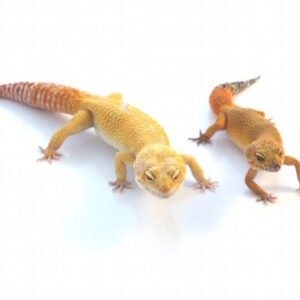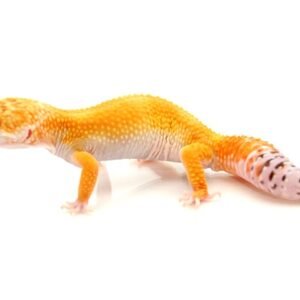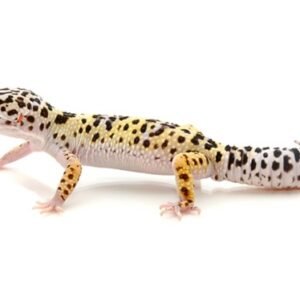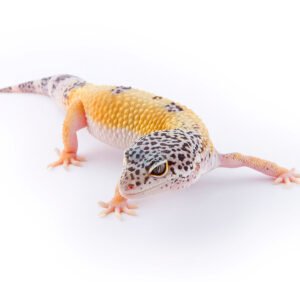Understanding the Snow Leopard Gecko: A Comprehensive Guide
Introduction to Snow Leopard Geckos
Snow leopard gecko , The snow leopard gecko, scientifically known as Eublepharis macularius, is a captivating reptile that has garnered significant attention within the pet trade due to its striking appearance and manageable care requirements. This unique gecko belongs to the family Eublepharidae, which is characterized by its distinctive lack of adhesive toe pads, setting it apart from other gecko species. Native to the arid regions of Central and South Asia, specifically India and Pakistan, this species thrives in rocky landscapes, making it adept at navigating its rugged habitat.
One of the most remarkable features of the snow leopard gecko is its stunning visual appeal. The snow leopard morph, in particular, showcases a beautiful palette of bright whites and yellows, punctuated by bold black spots. This intriguing coloration not only contributes to its popularity among reptile enthusiasts but also serves as a form of camouflage against the rocky terrain it inhabits in the wild. This visual allure is complemented by their large, expressive eyes and stout body, characteristics that make them an engaging presence in any terrarium.
The appeal of snow leopard geckos extends beyond their aesthetic charm. They are known for their amiable temperament, making them an excellent choice for both beginner and seasoned reptile keepers. Unlike some other species that exhibit skittish behavior, the snow leopard gecko generally adapts well to handling, often displaying a calm demeanor. This combination of striking looks and a friendly nature not only establishes the snow leopard gecko as a favored choice in the exotic pet trade, but it also highlights the importance of understanding their care needs and habitat requirements to ensure their well-being in captivity.
Care Requirements for Snow Leopard Geckos
Snow leopard gecko ,Providing appropriate care for snow leopard geckos is crucial for their health and well-being. This includes creating a suitable habitat that mimics their natural environment, ensuring optimal temperature and humidity levels, and offering a balanced diet. Understanding these elements enhances the care experience for owners while promoting the longevity of these remarkable reptiles.
When it comes to housing, snow leopard geckos thrive in a terrarium that is at least 20 gallons in size, allowing ample space for movement and exploration. The terrarium should include a substrate that is safe and comfortable, such as reptile carpet or paper towels, to avoid impaction. Additionally, hiding spots using rocks, caves, or wood can help reduce stress for the gecko, allowing them to feel secure in their environment.
Temperature and humidity are vital for the well-being of snow leopard geckos. The basking area should be maintained at around 90°F (32°C) while the cooler section of the tank should be approximately 75°F (24°C). Implementing a temperature gradient allows the gecko to self-regulate its body temperature. Humidity levels should be kept at around 30-40% with occasional misting to ensure hydration without excessive moisture, which can lead to health issues.
Diet plays a significant role in the health of snow leopard geckos. A variety of insects such as crickets, mealworms, and dubia roaches should be offered, with supplements of calcium and vitamins twice a week to promote strong bones and overall health. It’s also important to monitor their feeding habits and adjust the diet correspondingly to ensure optimal nutrition.
Regular health checks are essential to identify potential issues early on. Common health problems in snow leopard geckos include metabolic bone disease and respiratory infections, often resulting from improper care. By maintaining a suitable habitat, diet, and monitoring their health, owners can help ensure their gecko’s longevity and well-being.
Breeding Snow Leopard Geckos: An Overview
Snow leopard gecko ,Breeding snow leopard geckos can be a rewarding endeavor for enthusiasts and professionals alike. The first step in successful breeding is understanding the mating process. Snow leopard geckos reach sexual maturity at around 12 to 18 months of age, at which point males will begin exhibiting courtship behaviors. During this phase, males may engage in a variety of rituals, including head bobbing and tail waving, to attract females. Once a female is receptive, the mating can take place, which usually results in successful copulation.
After successful mating, the female will begin developing eggs, typically laying clutches of two eggs approximately two to four weeks later. Egg incubation is a critical stage in the breeding process. Ideal incubation temperatures range from 80°F to 90°F (27°C to 32°C), and humidity levels should be maintained between 50% and 70%. Substrates such as vermiculite or perlite are commonly used, as they offer excellent moisture retention while ensuring air circulation. The incubation period usually spans 30 to 60 days, with temperatures influencing the sex of the hatchlings—a fascinating aspect of leopard gecko breeding.
Upon hatching, snow leopard gecko hatchlings require specific care to thrive. It is important to provide a suitable habitat that includes hiding spots, a temperature gradient, and appropriate humidity levels. Hatchlings should be fed a diet of small insects such as pinhead crickets or fruit flies, gradually introducing larger food items as they grow. Genetic diversity is an essential consideration for breeders, as it helps prevent health issues related to inbreeding. Maintaining records of breeding pairs and their lineage can aid in managing this diversity.
Although breeding snow leopard geckos can pose challenges such as infertility, egg mortality, and the need for specialized care, the process can yield healthy offspring when approached thoughtfully. With due diligence in planning and execution, breeding these captivating reptiles can be a fulfilling experience.
The Importance of Conservation and Responsible Ownership
Snow leopard gecko ,Conservation efforts concerning the snow leopard gecko are crucial to ensuring the survival of this unique species in its natural habitat. As a species native to specific regions, these geckos face threats primarily from habitat loss due to urbanization, agricultural expansion, and climate change. The reduction of their natural environments not only jeopardizes their populations but also disrupts the entire ecosystem in which they thrive. Consequently, awareness and action towards habitat preservation are essential for the long-term survival of the snow leopard gecko in the wild.
In addition to habitat conservation, ethical considerations regarding the pet trade must be addressed. Many snow leopard geckos are captured from the wild for the exotic pet market, which can be detrimental to their populations. Ensuring that pet owners obtain their geckos from reputable breeders who prioritize ethical practices plays a vital role in mitigating the negative impact of the pet trade. By supporting captive breeding programs and ethically sourced animals, hobbyists can contribute positively to the sustainability of this species.
Responsible ownership goes beyond choosing the right source for obtaining a snow leopard gecko. It also involves creating a suitable living environment, understanding their dietary needs, and being familiar with their behavioral traits. Pet owners are encouraged to educate themselves about the specific requirements of these reptiles, including habitat temperature, humidity, and necessary social interactions. Through proper care, owners can promote the well-being of their pet while fostering a deeper appreciation for the species.
Members of the reptile community also have the opportunity to engage in conservation efforts actively. This can include participating in habitat restoration projects, supporting organizations focused on wildlife conservation, and raising awareness about the plight of the snow leopard gecko and its habitat. By promoting sustainable practices within the hobby, enthusiasts can help ensure that future generations can appreciate this beautiful species. In conclusion, fostering a culture of responsible ownership and conservation is critical for preserving the snow leopard gecko and its ecosystems. Through informed choices and active participation, we can contribute to a sustainable future for this remarkable reptile.





